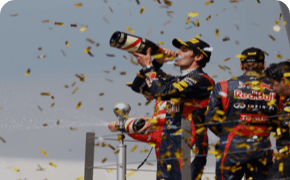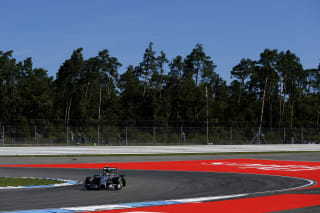Why go?
Lying so close to the home of German racing legend Michael Schumacher, Hockenheim was traditionally at the very heart of 'Schumi' hysteria. The seven-time champion may now be retired, but the subsequent success of compatriot and four-time champion Sebastian Vettel, and that of ‘home team’ Mercedes, means the tens of thousands who line the track every year are among the sport’s most fervent.
The spirit of Hockenheim has undoubtedly changed since the new, shortened track was introduced in 2002. Gone are the flat-out blasts through the forests that were the hallmark of the track when it was built by Mercedes-Benz as a test track in 1939. But what replaced it is both a great track for racing and much safer. The stadium section towards the end of the lap remains unchanged from its original format. The same giant grandstands continue to dwarf the track, giving it a unique and adrenaline-pumped atmosphere.
Hockenheim staged its first Grand Prix in 1970 and has since been the scene of many great races. Surprisingly, local hero Schumacher won the race only four times, but more recently Nico Rosberg has brought home success back to the venue, courtesy of his 2014 victory for Mercedes.
Did you know?
Wonder why the German fans are so happy? Frankfurt is regularly ranked among the top-ten best cities in the world for quality of life.
Transport
There are two big airports near to the track. Frankfurt is the closest (90 kilometres), with Stuttgart only 30 kilometres further away. These distances make a car most race-goers' preferred method of transport. And there is ample car parking space at the circuit because many fans camp in the forest adjacent to the track.
Coach services run from Frankfurt and Stuttgart to the towns surrounding Hockenheim, such as Heidelberg and Mannheim, while the nearest train stations are Schwetzingen and Heidelberg. However, you will still need to make the final part of the journey by car or taxi.
Useful tips
The track’s modern layout means plenty of grandstands, and not surprisingly they provide the best views. Ticket prices vary according to location, with the most sought-after seats being those overlooking the start-finish straight.
By northern European standards, Hockenheim is traditionally a hot race. Temperatures are usually in the high 20s Celsius, so make sure you pack the three S’s: shorts, shades and sun block.
Where to go?
Hockenheim is in a rural part of Germany, where the local farmers are infamous for complaining that the traffic at Grand Prix time gets in the way of the harvest, but that won’t stop you enjoying the area's beautiful countryside. The town itself boasts an unusual tobacco museum, while the collection at the Hockenheimring's motorsport museum includes various Grand Prix machines.
The nearest city of any size is Heidelberg, which boasts beautiful architecture and good restaurants. If you’re after a more vibrant nightlife, you can travel to Frankfurt or Stuttgart. Local places of interest are an extensive aviation museum in Speyer and, of course, the River Rhine, which flows nearby.
Where to stay?
There are plenty of hotel options available in Speyer, Mannheim and Heidelberg, all within half an hour’s drive of the track. Most hotels are small, family-run affairs, so if you want to stay in one of the international chains, you’ll have to head to the bigger cities of Frankfurt or Stuttgart.
Of course many would say camping is the best option. The partying of fellow fans may mean you don't sleep a great deal, but you will at least have lots of new friends by the end of the weekend.
Extended stay
For those who don't want to travel far from the circuit, Heidelberg and the River Rhine area provide both culture and natural beauty. If you like driving and want to have some fun, go to Schumacher’s hometown of Kerpen and try out the family kart centre.
Otherwise, why not check out Bavaria's stunning castles, or for a city break, how about Cologne? It’s only 240 kilometres away and is not too far from the Nurburgring.
Enthusiasts only
For some, Hockenheim is best remembered for the events of April 7, 1968. On that day, double world champion Jim Clark was killed at the first chicane in a Formula Two race and a monument to the Scotsman remains at the place where he died. It’s harder to locate since the track was re-configured in 2002, but if you walk into the forest in a straight line from Turn 2, you should find it.


















